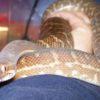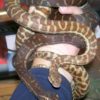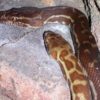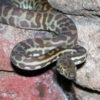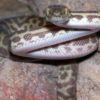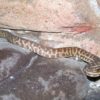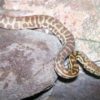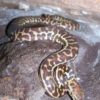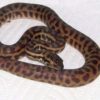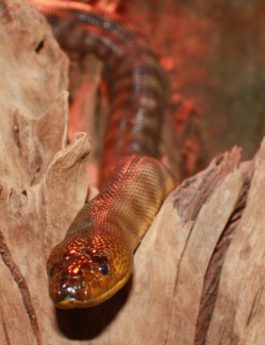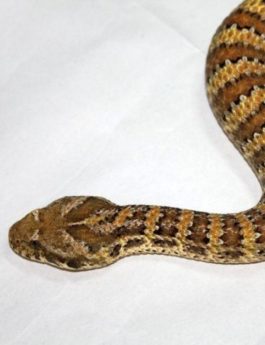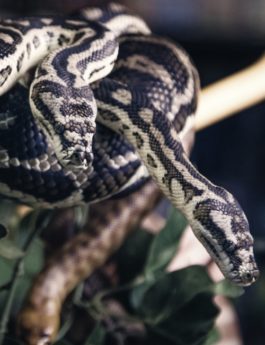Pattern usually prominent and including pale ventrolateral line. Has 260 – 302 ventral scales and usually 6th and 7th upper labial scales contacting eye. Pale brown, yellowish brown to cream, irregularly marked with darker brown to reddish brown, smooth-edged, circular to elongate blotches.
Terrestrial. Excavates sloping burrow, with expanded terminal cavity, at base of low vegetation. Several burrows may provide shelter for one individual. Shelters in hollow limbs, rock crevices and caves, abandoned burrows, termitaria and surface debris.
Terrarium: Stimson’s Pythons do not require an enclosure with very much height, however if given the correct environment with climbing enrichment they will explore their enclosure. The enclosure needs to be large enough to provide multiple hide rocks and maintain a thermal gradient, a terrarium that is 90x45x45cm (WxDxH) would be suitable to house a pair of mature Stimsons Pythons.
Lighting & heating: UVB lighting is not essential to Stimson’s Pythons, however a low 2.0 spectrum fluorescent globe can be used for viewing purposes. Heating can be provided with a heat tile, mat or cord to maintain a ground surface temperature of 32°C in the hot spot. Ambient heat can be provided with an infrared heat globe to maintain a daytime temperature of 32°C in the warm end and 20°C in the cool end, on warmer days you may not need to turn on the heat globe as the ambient temperature of the enclosure may already be high enough. A thermometer should always be used to monitor the temperature within the enclosure.
Furnishings: It is important to provide your Stimson’s Python with plenty of hide caves throughout, a water bowl at the cool end, and artificial plants will give coverage and decoration. Large Logs and vines can be used within the enclosure to provide climbing enrichment. A pet bedding wood chips such as Chipsi or Critter Crumble can be used as a substrate.
Food in captivity: All captive bred snakes must be fed dead food. An adult Stimson’s Python will eat a variety of frozen and thawed adult mice, fuzzy rats (slightly larger than adult mice) and day-old chickens. Young Stimson’s Pythons will feed on pinky mice, the size of their mice will increase as they grow. On average they will have 1-2 mice every 7-10 days.
The essentials:
- Terrarium of appropriate size
- Tummy heating
- Thermometer
- Infrared Heat globe
- Water bowl
- Substrate
- Hide caves
Foliage for shelter


